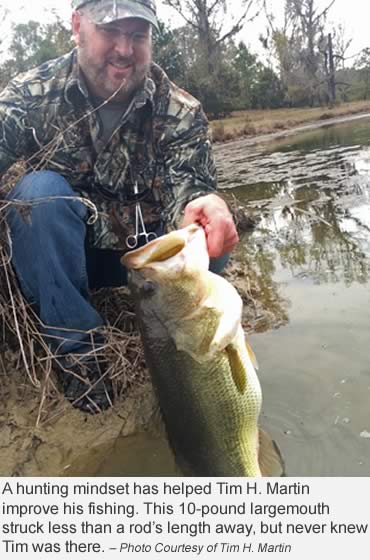By Tim H. Martin
Because so many Buckmasters fans love fishing, and because it’s summertime, I thought I’d share a philosophy on angling you might not have considered.
Angling is a form of hunting, especially if you are fishing from the bank. My grandfather taught me this way of thinking when I was a kid. It’s why I’m one of the world’s greatest fishermen.
That was a joke. But honestly, when I began to think of fishing with the mindset of a hunter, I brought home a lot more fish. FAR more than my brothers, but don’t tell them I said that.
Stalk the Banks
Fish have vibration sensors that run the length of their sides. These are called lateral lines. The line runs along the fish’s body, from gill flap to tail, and it’s easily visible. Think of it as the fish’s ears.
Fish can feel an ant drop into the water from an amazing distance, just as a deer can hear a twig snap from afar. I’ve learned to respect this survival feature.
Lateral lines detect vibrations from the ground — careless feet. Keep this in mind as you approach the bank, using your whitetail stalking skills to sneak in closer for a cast.
Because fish feel vibrations almost exclusively through the ground, this is why you can talk and not spook fish, but footsteps send them shooting into the depths.
Avoid Being Skylined
Skylining occurs when a deer spots you against a stark background, such as a treestand sitting in the open — any movement and you’re busted. The same happens in fishing, so stay low when approaching the bank.
 How low should you go? The less foliage there is behind you, the lower you should crouch.
How low should you go? The less foliage there is behind you, the lower you should crouch.
When approaching bedding bluegills in a farm pond located in the middle of a cow pasture, I will sometimes get down on my hands and knees to crawl close, then cast gently from a kneeling position.
Fishing in a forest or a tree-lined stream can be much more forgiving for an ambush. Use trees and bushes to conceal your approach.
Before You Cast, Scout
Hunters pause before easing into an opening. This gives us time to detect deer movement and see what’s what.
I learned to pause a moment before casting. This gives me time to scout for cruising fish, to check for submerged structure, and plan my course of action if I get a hookup. If something might impede me from landing a fish, I will back out carefully and move to a more strategically advantageous place. Think the situation through before casting, just as you would prepare for a shot when hunting furry game.
Wear Camo or Drab
Whenever I see a bank fisherman wearing white or a brightly colored shirt or cap, I shake my head. There’s no telling how many bites he DIDN’T get due to a bad clothing choice.
Bring out your camo for wary fish and give yourself an advantage. If you don’t wear camo, at least wear something drab. Gray, olive green and blue hues are good. Avoid reds.
Use your stalking skills, and think of fishing as hunting on the next trip to your honey hole. If these tactics work on whitetails, they’ll work on a spooky old bass or trout hiding in the shallows.
– Editor’s Note: Here’s a Cajun-fried bass recipe for the ages!
And don’t forget the beer-batter hush puppies!
– Photo Courtesy of Tim H. Martin
If you have a unique or special tip you’d like to share with Buckmasters fans, please email it to huntingtips@buckmasters.com and, if chosen, we will send you a cap signed by Jackie Bushman, along with a knife!
Read Recent Tip of the Week:
• Pre-seasoned Venison Trick: Here’s a neat tip for intensifying flavor in your wild game, as well as a link to Buckmasters’ collection of comfort food recipes!